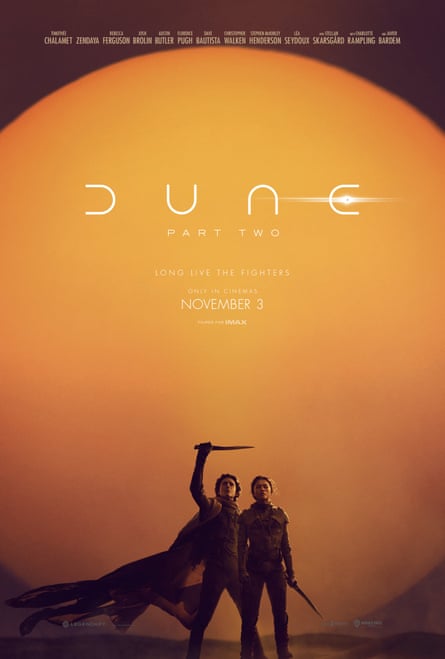It has often been noted that George Lucas’s 1977 film Star Wars was greatly influenced by Frank Herbert’s Dune. The desert-covered central planet; the blending of religion and magic to the point where they are virtually indistinguishable; the depiction of a galaxy where democracy has failed and gilded nobles battle for control of solar systems: all are present in both works of sci-fi-fantasy. And yet Dune is not Star Wars, even if Part Two, the first trailer for which dropped this week, will without doubt provide audiences with the burgeoning saga’s most Star Wars-like moment so far.
In 2021, the first part of Denis Villeneuve’s Dune adaptation managed the remarkable feat of keeping us interested despite focusing almost entirely on the horrifying fall of House Atreides at the hands of the putrid and relentless Harkonnens, and leaving any sense of hope and future glory seemingly buried deep beneath the sand dunes. In the book, there is always a sense that the Atreides’ forebears as rulers of Arrakis are going to get their comeuppance, because scion Paul is clearly going to end up as the Bene Gesserit’s predicted messiah and probably take over the known universe. In the film there are fewer hints but it matters less, because the sci-fi eye candy on display is like nothing we’d seen before on the big screen.
Interestingly, the new trailer shows us little of the spectacle we can expect in the finale of Dune: part two, when Christopher Walken’s Emperor Shaddam IV descends with all his armies on Arrakis, only to discover he really should have stayed at home. Instead we see more of Zendaya’s Chani, witness the transformation of Rebecca Ferguson’s Lady Jessica into the Freman’s tattooed, spice-loving Reverend Mother, and are introduced to Florence Pugh’s shifty Princess Irulan (daughter of the Emperor). There’s also a glimpse of the spectacular scenes from the book in which Paul Atreides first rides a giant sandworm.
Given the softly, softly approach to bringing Dune back to the big screen employed by studio Warner Bros, which was only prepared to film the novel one segment at a time, many fans of the book will just be pleased to see that Villeneuve didn’t end up pulling a Ralph Bakshi. Part two looks fittingly expansive, and there is still the prospect of the blockbuster denouement to come – which should make Luke blowing up the Death Star look like an episode of Doctors in terms of spectacle. And given that Dune earned more than $400m at the global box office, there is every chance its more feelgood and morally satisfying sequel should take the saga well past the £1bn mark. This is not a film whose chances we should worry about.
after newsletter promotion
It’s the future of the series I’m more concerned about. Dune is a very weird novel but its sequels only get stranger and more unorthodox the deeper Herbert gets into his weird and wonderful galaxy of human computers, psychedelia-inspired space travel and gene-modifying witch clans.
If the Star Wars saga was Dune, Return of the Jedi would have seen Luke decide it was a grand idea to turn to the dark side after all, then spend the rest of the movie regretting it. And without wishing to give too much away for those who haven’t read the novels, by book four (God Emperor of Dune), the main character is a part-human, part-sandworm megafreak who has been alive for more than 3,500 years. If Villeneuve and Warner Bros are still making movies about Dune at that point, it will be remarkable. If anyone is still watching, it will be a miracle.
Wisely, Villeneuve has only committed so far to a willingness to adapt Herbert’s first sequel, Dune: Messiah – which, while lacking the climactic cosmic battle that defines its predecessor, is at least packed with the political intrigue, high drama and millennia-spanning sorcerous conspiracies that drew fans to Arrakis in the first place.
It may be wise for the Canadian film-maker to draw the line there, perhaps after another two brilliant movies, before he finds the Mentats in white coats have turned up to take over the editing suite.

